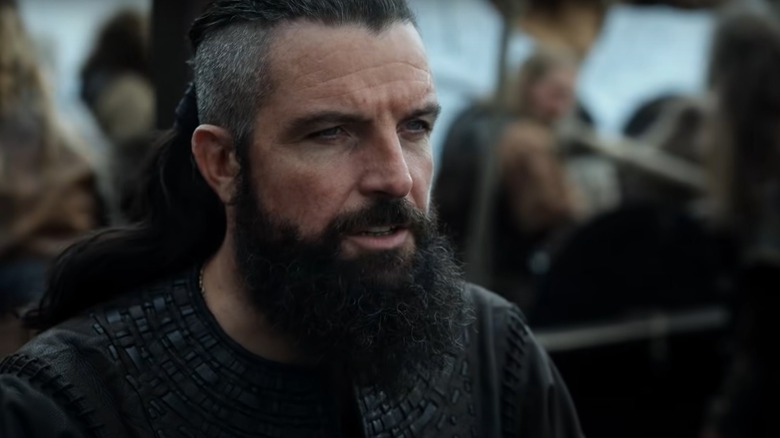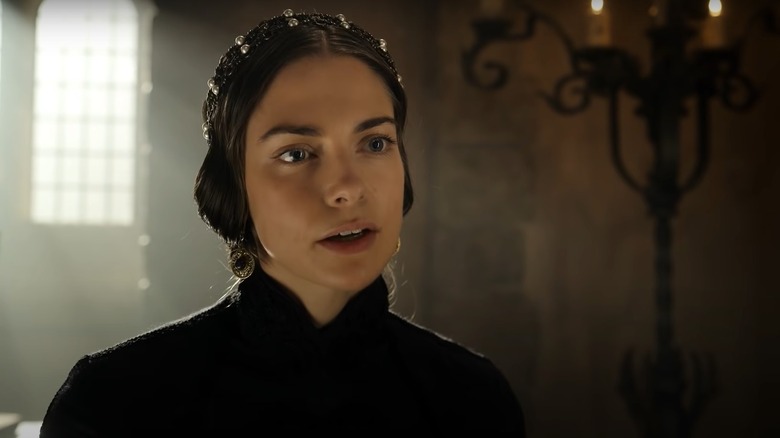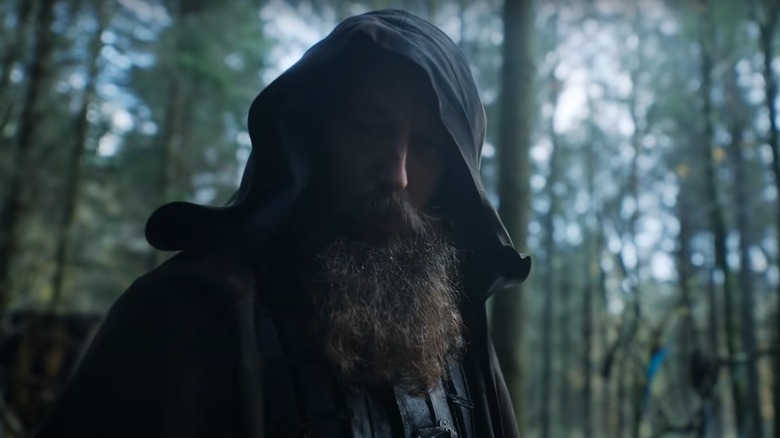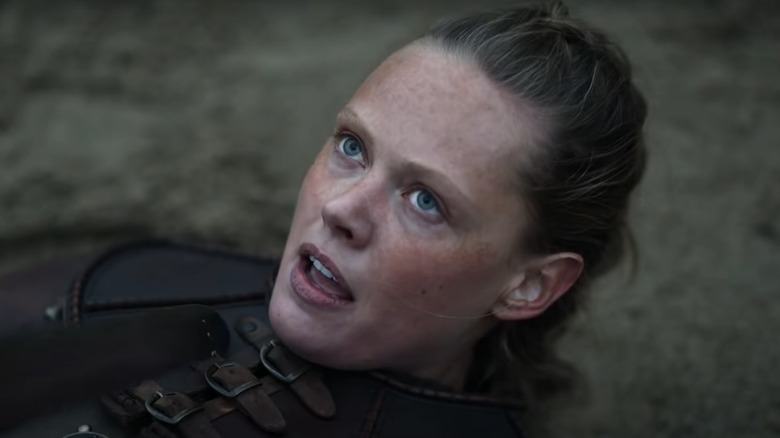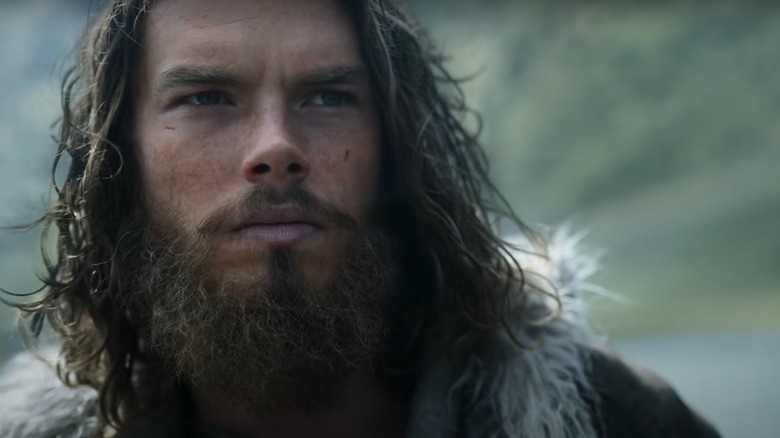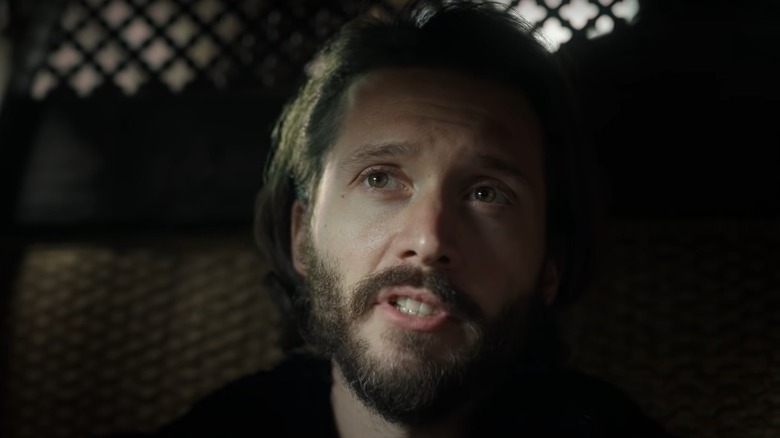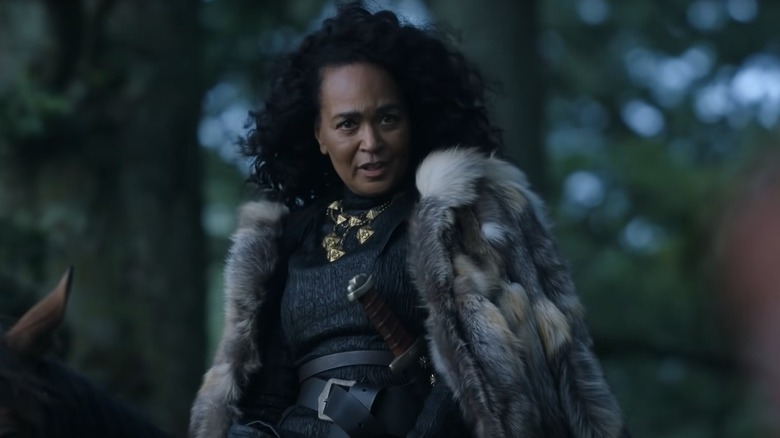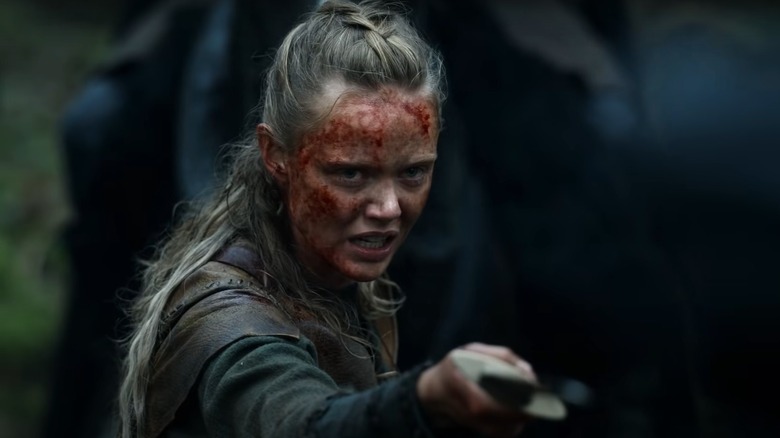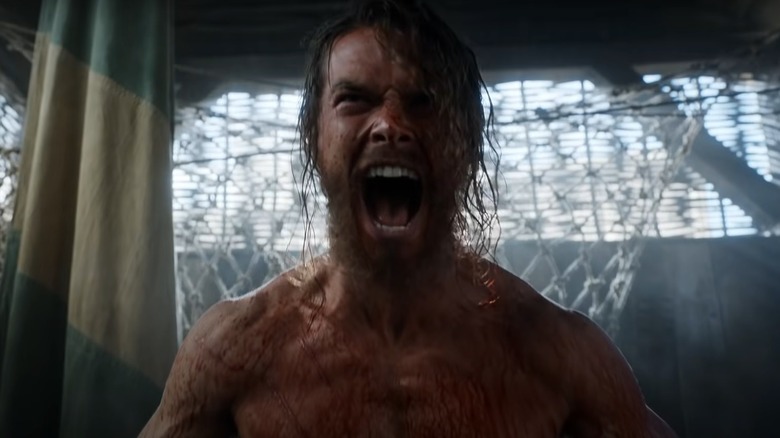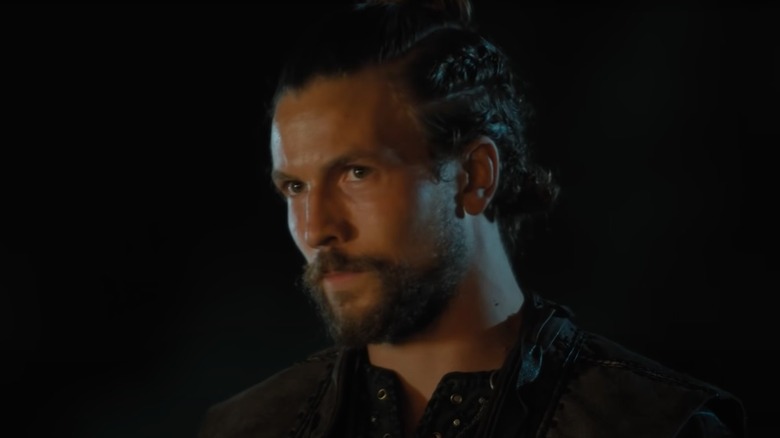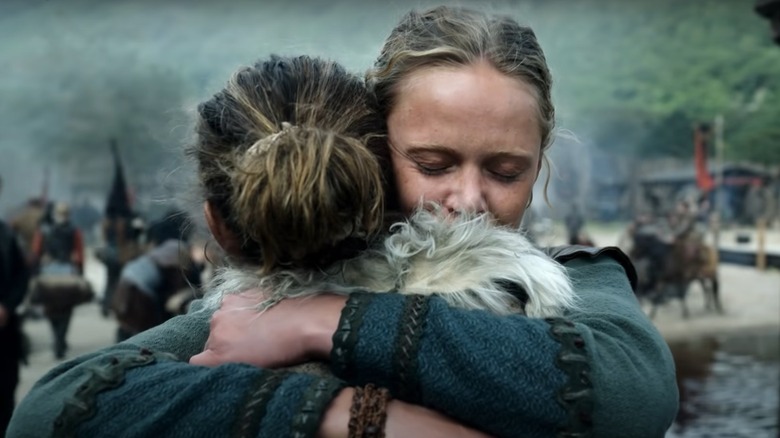The Ending Of Vikings: Valhalla Explained
Major spoilers for "Vikings: Valhalla" ahead.
Set over a hundred years after the events of the critically acclaimed show "Vikings," Netflix's sequel series "Vikings: Valhalla" takes place in a very different world. The word of Jesus Christ has spread to the far reaches of Northern Europe, and Christian Vikings regularly quarrel with Pagan ones. They can't stand each other for the most part, but a massacre of their people across the sea is about to unite them with a common cause.
At this point in time, Vikings have been settled in England for so long that many don't even speak the old tongue anymore. The way King Æthelred sees it, they have outstayed their welcome: the English ruler orders the death of all Danes living in his kingdom. When word of the St Brice's Day Massacre (a real event that took place in 1002) reaches Scandinavia, King Canute of Denmark forms a massive army of Vikings. He wants revenge, but that's not all he's after: the ambitious Dane plans on taking the throne of England.
Canute is supported by Prince Harald of Norway, who was able to escape the massacre and now wants Æthelred's head. Matters are complicated when they arrive in England and discover that Æthelred is already dead from natural causes. Allegiances are tested and webs of deceit are spun, culminating in a memorable finale. There's a lot to take in as all the story threads tie together in brutal and unexpected ways, so we're breaking down the show's ending.
Olaf risks the wrath of Canute
The beginning of the end of "Vikings: Valhalla," King Canute's decision to stay in England and rule over the conquered kingdom kicks off a chain of events that ends in death and destruction. His supposed ally King Olaf of Norway (Jóhannes Jóhannesson) harbors ambitions of uniting his country under the banner of Christianity, and that means overthrowing the free city of Kattegat. Olaf knows that Canute (Bradley Freegard) dreams of creating a great northern empire that stretches across the top of Europe and would never allow him to take control of Kattegat, an important trading post and the real seat of power in Norway. With Canute across the sea and smitten with the widow of England's King Æthelred (Bosco Hogan), Olaf decides to pay his friend's wife a visit.
That's right: Canute was already married to Queen Ælfgifu (Pollyanna McIntosh) when he set sail for England. Sensing an opportunity, Olaf drops in on Ælfgifu and tells her exactly what has been going on, hoping to talk her into lending him Canute's fleet. The queen ends up making her own play. After learning from Olaf that her husband was busy romancing the beautiful Emma of Normandy (Laura Berlin), she scoops up their kids and sets sail for England with the fleet in tow, intending to take her place as (in her opinion) its rightful queen. When she arrives, she discovers that Canute left to deal with an uprising — and he married Emma before he set sail.
Emma of Normandy outsmarts Queen Ælfgifu
Canute captured England by goading the young King Edmund (Louis Davison), son of the late King Æthelred, into a rash decision. Edmund led a charge across London's prized bridge after being called a coward, but he rode straight into a trap: the bridge was brought down behind him, stranding the English king. Prince Harald of Norway (Leo Suter) wanted to take his head when he found out that Æthelred was already dead, but Canute kept Edmund alive to act as a go-between with the English nobles. With the boy king under his wing and his marriage to Emma of Normandy (the great-granddaughter of Rollo) complete, Canute was in good shape, but the arrangement didn't work for Queen Ælfgifu.
With Canute gone, his father — the fearsome Sweyn Forkbeard (Soren Pilmark) — came to England to rule in his place. When Queen Ælfgifu arrived with Canute's fleet and informed Forkbeard that she was keeping its location secret until Emma was gone, he was furious, but his back was against the wall. In a very public spectacle, Emma's brother arrived to take her back to Normandy, much to Ælfgifu's delight. She still didn't reveal where the ships were, however, only promising that they would not aid Olaf. Ælfgifu went on a diplomatic mission to Mercia (her place of birth) believing that she had won Forkbeard over, but when she returned, she discovered that Emma's banishment was a charade: she was back, and Forkbeard had the time he needed to find the ships when she was gone.
Jarl Kåre takes his revenge
To help him in his quest to take Kattegat, King Olaf calls on the Christian zealot Kåre (Asbjørn Krogh Nissen), a murderous Jarl who hates Pagans. When we get his backstory, it's clear why: Kåre comes from a Pagan family who put forward one of their sons to be sacrificed to the gods. Seeing his older brother get his throat cut changed the young Kåre, who turned to Christ. He's been on a mission to cleanse the Viking world of Pagans, and nowhere is off limits. In a shocking turn of events, Jarl Kåre gains entrance to Uppsala (he shows the gatekeeper the palm of his hand, where he has a tattoo of the Norse rune of protection, Agliz) and proceeds to massacre the priests.
For maximum intimidation, Jarl Kåre decapitates the priests and hangs their heads from the mast of a ship that he then sends floating towards Kattegat. His men kill almost everyone in Uppsala, leaving only a few children alive to pass on a message to Freydis Eriksdotter (Frida Gustavsson). Kåre became fascinated with Freydis after finding out that she saw the Seer, and he wants her dead. He's convinced that he is the subject of the oracle's visions of the future, not Freydis. "It is I who is the cross that carries the sword, not this girl you prophesized," he declares to the Seer. Olaf thinks he's crazy (and he's probably right), but he secures him as an ally anyway.
The Last Daughter of Uppsala
The following entry contains mentions of rape.
Freydis Eriksdotter got the chance to visit Uppsala before Jarl Kåre burned it to the ground, a huge moment for her: as a Greenlander, Freydis still follows the old gods. She arrives in Kattegat at the beginning of "Vikings: Valhalla" not to answer the call of King Canute, but to find and kill a Christian Viking who raped her. It turns out her attacker is an important man in King Olaf's inner circle, but she kills him anyway, putting her at the mercy of Jarl Haakon (Caroline Henderson), leader of Kattegat. Despite Olaf's protests, Freydis is given the benefit of the doubt, seeing as she was within her rights to take revenge under Greenland's laws. She's ordered to remain in Kattegat, though Haakon allows Freydis to visit Uppsala, where she encounters the Seer.
The supernatural oracle tells Freydis that she is "the last," but she has no idea what that means. She only begins to understand the gravity of it when Haakon reveals to her that she has dreamed about a terrible disaster striking Kattegat: she sees the waves receding, revealing a bounty of fish for the people, only to come back as a wall of water. In Haakon's dream, a tsunami smashes into Kattegat and leaves just one survivor. For the longest time she believed that survivor was her, but after hearing what the Seer told Freydis, she's convinced that the Greenlander is actually the prophesized Last Daughter of Uppsala, and it's her she's been dreaming about.
Leif Eriksson steps out of his father's shadow
One of the conditions of Freydis Eriksdotter being allowed to live was that her brother must take the place of the man she killed when the Vikings left for England on their revenge mission. We know from the Sagas that Leif Eriksson (played by Australian actor Sam Corlett) was a famous Viking in his own right, but he's best known as the son of Erik the Red when we're introduced to him in "Vikings: Valhalla."
Erik the Red founded the Viking settlement in Greenland after being kicked out of Iceland for killing a man. Leif is attacked by the family of one of his father's victims while in Kattegat, but he lets them live, not wanting to be like his dad. He goes to England and steps out of his father's shadow in style (it's Leif who brings down London Bridge), but it's not without cost: the Pagan Greenlander begins to experience a crisis of faith.
After nearly being killed in an ambush, a local girl puts a cross in his hand. He survives, and he can't help but wonder if it was Jesus who saved him. His Christian comrade Prince Harald calls it a miracle. By the time Leif returns to Norway, he's clearly having doubts about the old ways. His sister looks on with a smile as the priests of Kattegat make a human sacrifice to gain the favor of the gods ahead of the coming invasion from Olaf, but Leif looks disturbed.
Godwin kills the boy king
Low-ranking Saxon Godwin (David Oakes) is a savvy social climber. He let Prince Harald escape during the St Brice's Day Massacre, which paid off for him when the Vikings came to take their revenge. He ends up becoming an advisor to King Canute, though he's still loyal to the English king, young Edmund — at least to begin with. When Canute is called away and his father, Sweyn Forkbeard, is suddenly calling the shots, things quickly change.
Edmund can't stand Forkbeard: he calls him an "abomination" in a private moment with Godwin. When Godwin replies with "How much do you hate him?," Edmund reads between the lines: there's a plot afoot. Godwin has convinced the English nobles to back Edmund, but something happens that makes him reconsider his options. Forkbeard kills the Ealdorman of Wessex, and, believing him to be trustworthy, he makes Godwin the first Earl of Wessex. All of a sudden, it's Edmund that Godwin needs out of the picture, not Forkbeard.
Godwin uses a hidden rope to bring Edmund off his horse, and when his injuries aren't quite severe enough to kill him, he stabs him in the heart for good measure. It appears as though he's gotten away with murder, though Queen Emma notices the wound and sees right through him. Forkbeard ultimately stepped in on his behalf, but Emma is unlikely to forget the murder of her late husband's son in a hurry. Godwin will need to watch his back in Season 2.
Jarl Haakon's Kattegat falls
After pledging allegiance to Kattegat, Prince Harald leaves the city and rejoins his half-brother, King Olaf. With Jarl Kåre and his warriors onside, Olaf's chances of taking Kattegat and becoming the undisputed king of Norway seem high. Having learned of their plan, the undercover Harald forces Kåre into offering a parlay by essentially out-Christianing him: He tells Kåre that their Lord does not look kindly on those who deny entry to the Kingdom of Heaven to those who seek it and that they should at least ask the Pagans to convert before massacring them. Begrudgingly, Kåre agrees.
Of course, Harald knows full well that Jarl Haakon would never agree to a mass Christian conversion in the proudly multi-faith Kattegat, but the brief parlay gives him time to pass a secret message to Leif. With a hand signal and some clever wording, he informs him that Kåre will attack by land while Olaf will come from the sea, using the hide tide of the wolf moon to bypass the defenses. Trebuchets are brought to the fjord and Kattegat's forces are split in two, but what Harald doesn't know is that his devious half-brother has tricked both him and Kåre. Knowing that Harald would share the plan with Kattegat, Olaf sent a bunch of empty ships floating towards the city. His real intention was to let the armies of Jarl Haakon and Jarl Kåre destroy each other before swooping in to pick up the pieces.
Freydis delivers her justice
With Olaf secretly waiting in the wings, the forces of Jarl Kåre descend on Kattegat. The crazed Christian Viking asks for no payment for his services, telling Olaf that all he wants in return is to build a huge church in the middle of the city once they've taken it. God has instructed him to make it so tall that it touches the sky, he tells Olaf. Kåre's berserkers are relentless as they scale the walls and enter the city, but so are Haakon's shieldmaidens, who manage to get her to safety after she's hit with numerous arrows. She isn't fated to survive, but before she goes to Valhalla, she reminds Freydis that she's the Last Daughter of Uppsala and must live. Freydis won't abandon Kattegat without settling her score first, however.
The big showdown between Freydis and Kåre is teased throughout the first season of "Vikings: Valhalla," and it doesn't disappoint. Freydis is given a sword by the priests of Uppsala during her visit, and she's almost struck down with it: Kåre disarms her, but he doesn't act quickly enough. Freydis pounces and stabs him with a dagger before retrieving her sword and hitting Kåre with a truth bomb: "The cross that carries the sword was never you," she tells him. "It was my destiny." Kåre's last word is "no" as Freydis brings her blade down, decapitating him as he had done to so many at Uppsala.
Leif Eriksson is off the leash
With both Jarl Haakon and Jarl Kåre out of the way, taking Kattegat is relatively easy for Olaf. He and his men storm the city and make their way to the great hall, killing any stragglers who stand in their way. In a move that he will no doubt come to regret in coming seaons, Olaf slays the Greenlander Liv, the only person keeping Leif Eriksson on the straight and narrow. The son of Erik the Red had opened up to Liv, telling her all about his traumatic childhood and how his father controlled Greenland through fear: He once saw him beat a man until he couldn't walk because the lamb he owed him had not been born yet. That same "darkness" lives inside Leif, he says, and he only feels calm and content when he's with Liv.
Liv's death is crushing for Leif, who instantly regrets not being able to comfort her more in her final moments. "I'm going to Valhalla, I need you to tell me you'll join me there, tell me you believe that?" says Liv, but she dies before he can answer. When his mourning is interrupted by a group of men, he snaps. They barely even notice Leif hunched next to Liv's body as they burst into the barn he's in, but they've chosen the wrong Viking to mess with: by the time he's done with them, he's covered in so much blood that you could call him Leif the Red.
Prince Harald is destined to become a hard ruler
As viewers, we aren't entirely sure which side Harald Sigurdsson (the great-grandson of Harald Finehair) is on leading up to the battle for Kattegat, but he proves himself loyal to the city, and to Freydis. Harald declares his love to the Pagan shieldmaiden from Greenland before he secretly goes undercover in Olaf's camp, and when Freydis spots him wounded on the ground, she follows her heart and saves him. With the city lost, the two flee Kattegat on horseback and live to fight another day. They finish the season together, but how long their relationship will last is up for debate — their vastly different outlooks on religion could well drive a wedge between them going forward.
When the Christian Prince dismisses a comment about life being fated, the staunchly Pagan Freydis says that loving him is sometimes "hard," a word that Harald is associated with to this day. The Viking Sagas tell us that Harald Sigurdsson went on to become the king known as Harald Hardrada, meaning Harald Hard-ruler. Olaf's forces flee from Kattegat when Sweyn Forkbeard arrives with his son's fleet, and he's clearly going to be in Canute's bad books for a while if he manages to keep his head. That means Harald will likely be crowned king of Norway in "Vikings: Valhalla" Season 2, but he doesn't seem like the iron-fisted type just yet. Perhaps heartbreak will turn him into the hard ruler history remembers him as?
The children of Erik the Red have their own sagas to write
We can also expect to see the children of Erik the Red inching closer to their destinies in "Vikings: Valhalla" Season 2. Leif Eriksson is popularly known as one of the first Europeans to set foot on North American soil, having landed in present-day Canada around 500 years before Christopher Columbus set sail. According to "The Saga of the Greenlanders," Leif heard about a new land with a milder climate from an Icelandic trader, who caught a glimpse of the lush woodlands and vast mountains from a distance but didn't go ashore. Leif set out to do just that, and he would end up making several stops along the Atlantic coast, eventually setting up a camp in a place he called Vinland because of the abundance of grapes.
Leif wasn't the only child of Erik to Red to make the trip to the new world, either. Freydis is also said to have sailed to North America, and she apparently stayed there for a lot longer: Leif wintered in Vinland, but his sister was away for three years. She helped create a settlement in Vinland, where the Greenlanders co-existed peacefully with the Native Americans for some time. Tensions eventually spilled into conflict, however, and, according to "The Saga of Erik the Red," Freydis went into battle while heavily pregnant. While Norsemen have already set foot in America in the "Vikings" universe (Floki was apparently the first to arrive), we still expect Leif to make the journey.

